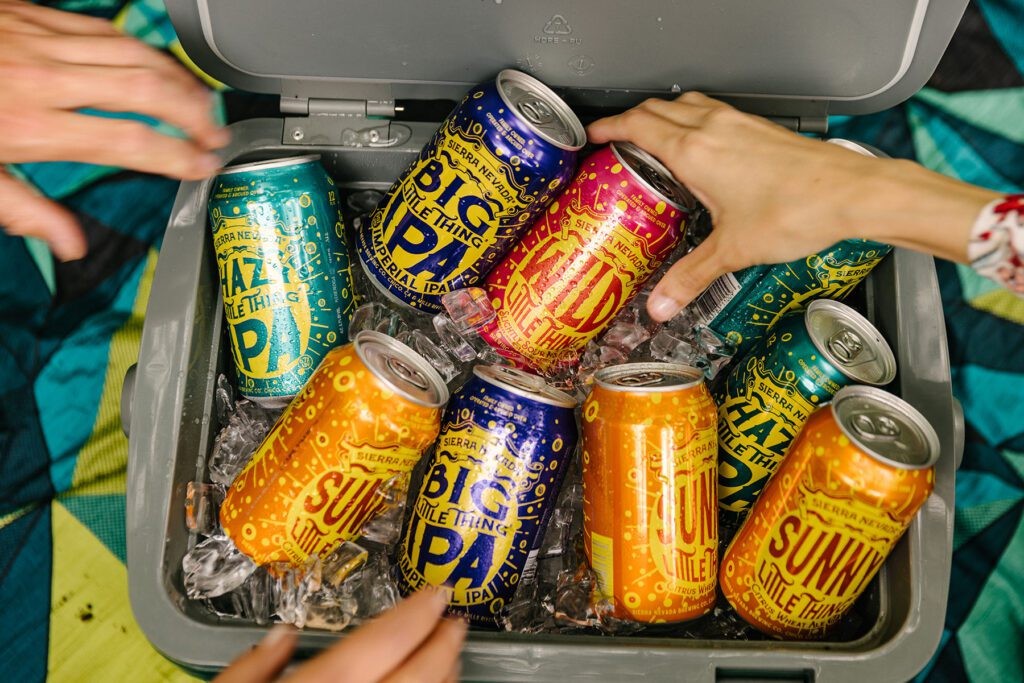Are you curious about what IBU in beer means? WHAT.EDU.VN explains International Bitterness Units (IBU) and how they measure the bitterness of beer, helping you choose your next favorite brew. Discover how IBUs, hop varieties, and other ingredients influence the overall flavor profile of your beer, ensuring you find the perfect balance of bitterness and taste. Explore the world of beer bitterness, understand the IBU scale, and learn how it affects your beer-drinking experience with our beer guide.
1. What Does IBU Stand For in Beer?
IBU stands for International Bitterness Units. It’s a measurement of the bitterness in beer caused by the iso-alpha acids from hops. The IBU scale helps beer drinkers understand how bitter a beer will taste.
When you see IBU on a beer label or menu, it tells you about the beer’s bitterness level, mainly from hops. Inside hop cones are tiny yellow pods called lupulin, filled with essential oils and resins that give beer its aroma, flavor, and bitterness. According to brewing experts, bitterness perception can vary based on other ingredients in the beer, such as malt sweetness, which can balance the bitterness.
2. How is IBU Measured in Beer?
IBU is measured through a scientific process that quantifies the amount of iso-alpha acids in beer. These acids are extracted using an organic solvent, and the resulting solution is exposed to ultraviolet light.
The more UV light absorbed by the solution, the higher the IBU. This process provides a standardized way to determine the bitterness level in beer. According to a study by the American Society of Brewing Chemists, this method ensures consistent and accurate measurement of bitterness across different beers and breweries.
3. What is the IBU Scale for Beer Bitterness?
The IBU scale ranges from 0 to 100, with higher numbers indicating greater bitterness. Most beers fall within the 5-70 IBU range.
Beers with an IBU of 5-15 are generally very mild and have little noticeable bitterness, while those above 50 IBU can be quite bitter. According to beer expert Charlie Bamforth, “the highest value you can get is 100, no matter what some people claim.”
3.1 IBU Scale Ranges
- 0-10 IBU: Very little to no perceived bitterness. Examples include light lagers and some wheat beers.
- 10-25 IBU: Mild bitterness, often balanced by malt sweetness. Examples include many blonde ales and pilsners.
- 25-45 IBU: Moderate bitterness, common in many pale ales and IPAs.
- 45-70 IBU: Noticeable bitterness, typical of many IPAs and some strong pale ales.
- 70-100 IBU: High bitterness, found in some Imperial IPAs and barleywines.
4. What Factors Affect Perceived Bitterness in Beer?
Several factors can influence how bitter a beer tastes beyond just the IBU number, including malt sweetness, hop aroma, and overall balance.
Malt sweetness can counteract bitterness, making a beer with a high IBU seem less bitter. Hop aroma can also influence perceived bitterness, with some aromatic hops adding to the perception of bitterness. According to research from Oregon State University’s Fermentation Science Program, the balance between bitterness, sweetness, and other flavor components is crucial in determining the overall drinking experience.
5. How Does Hop Variety Influence IBU?
Different hop varieties contain varying amounts of bitter acids, which directly impact a beer’s IBU. Some hops are known for their high alpha acid content, contributing more bitterness.
For instance, hops like Columbus, Zeus, and Centennial are often used to add significant bitterness to beers. Other hops, such as Cascade and Citra, contribute more aroma and flavor than bitterness. According to the Hop Growers of America, the choice of hop variety is a critical factor in achieving the desired bitterness level in beer.
6. Can Other Ingredients Besides Hops Contribute to Bitterness?
While hops are the primary source of bitterness in beer, other ingredients like roasted malts and certain adjuncts can also contribute to the overall bitterness profile.
Roasted malts, especially those used in stouts and porters, can add a roasty, bitter flavor that complements the bitterness from hops. Certain spices and herbs can also introduce bitter notes. A study by the Institute of Brewing and Distilling highlights that brewers often use a combination of ingredients to create complex and balanced bitterness profiles in beer.
7. What is the Relationship Between IBU and Beer Style?
Different beer styles typically have different IBU ranges. For example, light lagers usually have low IBUs, while IPAs tend to have higher IBUs.
Understanding the typical IBU range for a beer style can help you predict how bitter it will taste. American wheat beers often have an IBU range of 10-35, while American stouts can reach up to 60 IBU. According to the Brewers Association, knowing the IBU ranges for different styles can enhance your appreciation and enjoyment of beer.
7.1 Common Beer Styles and Their IBU Ranges
- Lager: 5-25 IBU
- Pilsner: 25-45 IBU
- Pale Ale: 30-50 IBU
- IPA: 40-70 IBU
- Imperial IPA: 60-100+ IBU
- Stout: 25-60 IBU
- Barleywine: 35-100 IBU
8. How Can I Use IBU to Choose a Beer?
Using the IBU value can help you choose a beer that matches your preferred level of bitterness. If you enjoy a more bitter taste, look for beers with higher IBUs.
If you prefer milder flavors, opt for beers with lower IBUs. It’s also helpful to consider the overall flavor profile of the beer, as other ingredients can influence how the bitterness is perceived. According to beer enthusiasts at RateBeer, paying attention to IBU is a good starting point, but understanding the beer’s other characteristics is essential for making the best choice.
9. Is Higher IBU Always Better?
No, higher IBU is not always better. The ideal IBU level depends on personal preference and the specific beer style.
Some people enjoy intensely bitter beers, while others prefer a more balanced or milder flavor. A high IBU beer may not be enjoyable if it’s not balanced by other flavors, such as malt sweetness or fruity hop aromas. According to the Beer Judge Certification Program (BJCP), the best beers are those that achieve a harmonious balance of all flavor components.
10. What are Some Common Misconceptions About IBU?
One common misconception is that IBU is the only factor determining bitterness. Other factors like malt, hop aroma, and water chemistry play significant roles.
Another misconception is that higher IBU always means a more enjoyable beer. Personal preference and balance are more important than simply having a high IBU. As noted in “The Oxford Companion to Beer,” a balanced beer with moderate bitterness can be more satisfying than an overly bitter one.
11. How Do Brewers Control IBU Levels?
Brewers control IBU levels through various techniques, including adjusting the amount and type of hops used, the timing of hop additions, and the brewing process.
Adding hops early in the boil contributes more bitterness, while adding them later contributes more aroma and flavor. Brewers also carefully select hop varieties based on their alpha acid content to achieve the desired IBU. According to brewing science resources, precise control over these factors is essential for creating consistent and high-quality beers.
12. What Role Does Water Chemistry Play in IBU Perception?
Water chemistry can significantly impact IBU perception. The mineral content of water can affect how bitter acids are extracted from hops during the brewing process.
For example, water with high sulfate levels can enhance the perception of bitterness, while high chloride levels can soften it. Brewers often adjust their water chemistry to optimize the bitterness profile of their beers. According to the book “Water: A Comprehensive Guide for Brewers,” understanding and controlling water chemistry is crucial for achieving the desired flavor and bitterness in beer.
13. How Does Aging Affect IBU in Beer?
Aging can affect IBU in beer, typically causing the perceived bitterness to decrease over time. This is because the bitter compounds from hops can degrade and mellow as the beer ages.
The rate at which bitterness decreases depends on the beer style, storage conditions, and initial IBU level. High-IBU beers may retain more bitterness over time than low-IBU beers. According to research published in the Journal of the American Society of Brewing Chemists, understanding how aging affects bitterness is important for brewers and consumers alike.
14. What is the Difference Between Perceived Bitterness and Measured IBU?
Perceived bitterness is how bitter a beer tastes to an individual, while measured IBU is the scientific measurement of bitter acids in the beer.
Perceived bitterness can be influenced by factors like malt sweetness, hop aroma, and individual taste preferences, which may not be reflected in the IBU number. It’s essential to consider both the measured IBU and the overall flavor profile to understand how bitter a beer will taste. As explained by beer experts, the subjective experience of bitterness can vary widely from person to person.
15. How Does Dry Hopping Affect IBU?
Dry hopping, the process of adding hops after the boil, primarily affects aroma and flavor but has minimal impact on IBU.
Since dry hopping does not involve boiling, the alpha acids in the hops are not isomerized, which is necessary for bitterness. Dry hopping can enhance the perceived bitterness indirectly by adding complex aromas that complement the overall flavor profile. According to brewing professionals, dry hopping is a key technique for adding hop character without significantly increasing bitterness.
16. Can You “Taste” the IBU Number Directly?
While you can’t taste the IBU number directly, experienced beer drinkers can often estimate the IBU range based on the beer’s bitterness level.
However, it’s difficult to pinpoint the exact IBU number without scientific measurement. Factors like individual taste sensitivity and the beer’s overall balance can make it challenging to accurately assess IBU by taste alone. As highlighted in beer education courses, developing an understanding of different IBU levels can improve your ability to appreciate and describe beer.
17. What are Some Beers Known for Their High IBU?
Several beers are known for their high IBU levels, often exceeding 70 or even 100 IBU. These beers are typically Imperial IPAs or barleywines designed to deliver a strong, bitter flavor.
Examples include Pliny the Elder (Russian River Brewing), Hoptimum Triple IPA (Sierra Nevada), and various other aggressively hopped beers. According to beer rating websites, these beers are often sought after by those who enjoy intense bitterness.
18. How Does Food Pairing Influence IBU Perception?
Food pairing can significantly influence IBU perception. Certain foods can either enhance or diminish the perceived bitterness of a beer, depending on their flavors and characteristics.
For example, pairing a high-IBU beer with fatty or rich foods can help balance the bitterness, while pairing it with spicy foods can amplify the bitterness. According to culinary experts, understanding these interactions can help you create enjoyable and complementary food and beer pairings.
18.1 Food Pairings for Different IBU Levels
- Low IBU (0-25): Light salads, seafood, mild cheeses
- Moderate IBU (25-45): Grilled chicken, burgers, pizza
- High IBU (45-70): Spicy dishes, rich meats, strong cheeses
- Very High IBU (70+): Bold flavors, hearty stews, aged cheeses
19. What is the Future of IBU Measurement and Perception?
The future of IBU measurement and perception may involve more advanced techniques for quantifying bitterness and a greater emphasis on understanding individual taste preferences.
Researchers are exploring new methods for measuring bitterness that take into account the complex interactions between different flavor compounds. Additionally, personalized beer recommendations based on individual taste profiles may become more common. According to emerging trends in the brewing industry, these developments could lead to more informed and satisfying beer experiences.
20. How Can I Learn More About IBU and Beer Bitterness?
You can learn more about IBU and beer bitterness through various resources, including books, websites, courses, and beer tastings.
Attending beer festivals and joining beer clubs can provide opportunities to sample different beers and discuss their characteristics with other enthusiasts. Online resources like the Brewers Association and the Beer Judge Certification Program (BJCP) offer valuable information on beer styles, brewing techniques, and flavor profiles.
20.1 Resources for Learning About IBU and Beer Bitterness
- Books: “The Oxford Companion to Beer,” “Tasting Beer” by Randy Mosher
- Websites: Brewers Association, Beer Judge Certification Program (BJCP)
- Courses: Beer sommelier certifications, brewing courses at local colleges
- Events: Beer festivals, brewery tours, beer tastings
Are you still curious about beer and its various aspects? Do you want to understand the nuances of different brews and find your perfect taste? At WHAT.EDU.VN, we offer a platform where you can ask any question about beer, brewing, and beyond, completely free of charge. Our community of experts is ready to provide clear, accurate, and helpful answers to all your queries.
Don’t hesitate—visit WHAT.EDU.VN today and ask your question. Expand your beer knowledge and discover new favorites with the help of our knowledgeable community. For any questions or assistance, contact us at 888 Question City Plaza, Seattle, WA 98101, United States, or reach us via WhatsApp at +1 (206) 555-7890.
Let what.edu.vn be your go-to resource for all things beer!


